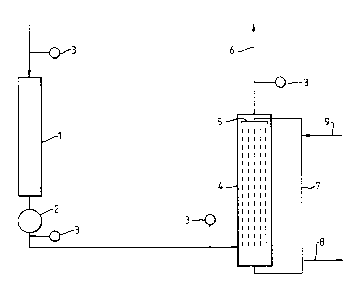Une partie des informations de ce site Web a été fournie par des sources externes. Le gouvernement du Canada n'assume aucune responsabilité concernant la précision, l'actualité ou la fiabilité des informations fournies par les sources externes. Les utilisateurs qui désirent employer cette information devraient consulter directement la source des informations. Le contenu fourni par les sources externes n'est pas assujetti aux exigences sur les langues officielles, la protection des renseignements personnels et l'accessibilité.
L'apparition de différences dans le texte et l'image des Revendications et de l'Abrégé dépend du moment auquel le document est publié. Les textes des Revendications et de l'Abrégé sont affichés :
| (12) Brevet: | (11) CA 2085877 |
|---|---|
| (54) Titre français: | PRODUCTION D'OXYDE D'ETHYLENE |
| (54) Titre anglais: | PRODUCTION OF ETHYLENE OXIDE |
| Statut: | Durée expirée - au-delà du délai suivant l'octroi |
| (51) Classification internationale des brevets (CIB): |
|
|---|---|
| (72) Inventeurs : |
|
| (73) Titulaires : |
|
| (71) Demandeurs : |
|
| (74) Agent: | MARKS & CLERK |
| (74) Co-agent: | |
| (45) Délivré: | 2002-09-24 |
| (86) Date de dépôt PCT: | 1991-06-18 |
| (87) Mise à la disponibilité du public: | 1991-12-26 |
| Requête d'examen: | 1998-05-28 |
| Licence disponible: | S.O. |
| Cédé au domaine public: | S.O. |
| (25) Langue des documents déposés: | Anglais |
| Traité de coopération en matière de brevets (PCT): | Oui |
|---|---|
| (86) Numéro de la demande PCT: | PCT/GB1991/000976 |
| (87) Numéro de publication internationale PCT: | GB1991000976 |
| (85) Entrée nationale: | 1992-12-18 |
| (30) Données de priorité de la demande: | |||||||||
|---|---|---|---|---|---|---|---|---|---|
|
A gas stream from a reaction in which ethylene oxide is produced by reacting
ethylene with oxygen which gas stream com-
prises oxides of nitrogen and steam the gas stream is contacted with an
aqueous alkaline quench solution and ethylene oxide is
then recovered from the gas stream. A substantial amount of oxides of nitrogen
is removed from the gas stream during the treat-
ment with, the quench solution.
Note : Les revendications sont présentées dans la langue officielle dans laquelle elles ont été soumises.
Note : Les descriptions sont présentées dans la langue officielle dans laquelle elles ont été soumises.

2024-08-01 : Dans le cadre de la transition vers les Brevets de nouvelle génération (BNG), la base de données sur les brevets canadiens (BDBC) contient désormais un Historique d'événement plus détaillé, qui reproduit le Journal des événements de notre nouvelle solution interne.
Veuillez noter que les événements débutant par « Inactive : » se réfèrent à des événements qui ne sont plus utilisés dans notre nouvelle solution interne.
Pour une meilleure compréhension de l'état de la demande ou brevet qui figure sur cette page, la rubrique Mise en garde , et les descriptions de Brevet , Historique d'événement , Taxes périodiques et Historique des paiements devraient être consultées.
| Description | Date |
|---|---|
| Inactive : Périmé (brevet - nouvelle loi) | 2011-06-18 |
| Inactive : Lettre officielle | 2009-04-16 |
| Lettre envoyée | 2008-10-23 |
| Lettre envoyée | 2008-10-23 |
| Lettre envoyée | 2008-10-23 |
| Inactive : Transferts multiples | 2008-07-18 |
| Inactive : CIB de MCD | 2006-03-11 |
| Accordé par délivrance | 2002-09-24 |
| Inactive : Page couverture publiée | 2002-09-23 |
| Préoctroi | 2002-07-10 |
| Inactive : Taxe finale reçue | 2002-07-10 |
| Un avis d'acceptation est envoyé | 2002-01-14 |
| Lettre envoyée | 2002-01-14 |
| Un avis d'acceptation est envoyé | 2002-01-14 |
| Inactive : Approuvée aux fins d'acceptation (AFA) | 2001-12-18 |
| Modification reçue - modification volontaire | 2001-11-08 |
| Inactive : Dem. de l'examinateur par.30(2) Règles | 2001-07-11 |
| Modification reçue - modification volontaire | 2001-04-17 |
| Lettre envoyée | 2001-03-07 |
| Exigences de prorogation de délai pour l'accomplissement d'un acte - jugée conforme | 2001-03-07 |
| Demande de prorogation de délai pour l'accomplissement d'un acte reçue | 2001-02-16 |
| Inactive : Dem. de l'examinateur par.30(2) Règles | 2000-10-16 |
| Inactive : Renseign. sur l'état - Complets dès date d'ent. journ. | 1998-07-08 |
| Inactive : Acc. réc. RE - Pas de dem. doc. d'antériorité | 1998-07-08 |
| Inactive : Dem. traitée sur TS dès date d'ent. journal | 1998-07-08 |
| Exigences pour une requête d'examen - jugée conforme | 1998-05-28 |
| Toutes les exigences pour l'examen - jugée conforme | 1998-05-28 |
| Lettre envoyée | 1998-01-21 |
| Inactive : Supprimer l'abandon | 1998-01-07 |
| Lettre envoyée | 1997-10-20 |
| Exigences de rétablissement - réputé conforme pour tous les motifs d'abandon | 1997-10-08 |
| Réputée abandonnée - omission de répondre à un avis sur les taxes pour le maintien en état | 1997-06-18 |
| Demande publiée (accessible au public) | 1991-12-26 |
| Date d'abandonnement | Raison | Date de rétablissement |
|---|---|---|
| 1997-06-18 |
Le dernier paiement a été reçu le 2002-03-11
Avis : Si le paiement en totalité n'a pas été reçu au plus tard à la date indiquée, une taxe supplémentaire peut être imposée, soit une des taxes suivantes :
Les taxes sur les brevets sont ajustées au 1er janvier de chaque année. Les montants ci-dessus sont les montants actuels s'ils sont reçus au plus tard le 31 décembre de l'année en cours.
Veuillez vous référer à la page web des
taxes sur les brevets
de l'OPIC pour voir tous les montants actuels des taxes.
Les titulaires actuels et antérieures au dossier sont affichés en ordre alphabétique.
| Titulaires actuels au dossier |
|---|
| IMPERIAL CHEMICAL INDUSTRIES PLC |
| DOW TECHNOLOGY INVESTMENTS LLC |
| Titulaires antérieures au dossier |
|---|
| JAMES ROBERT JENNINGS |
| PERCY HAYDEN |